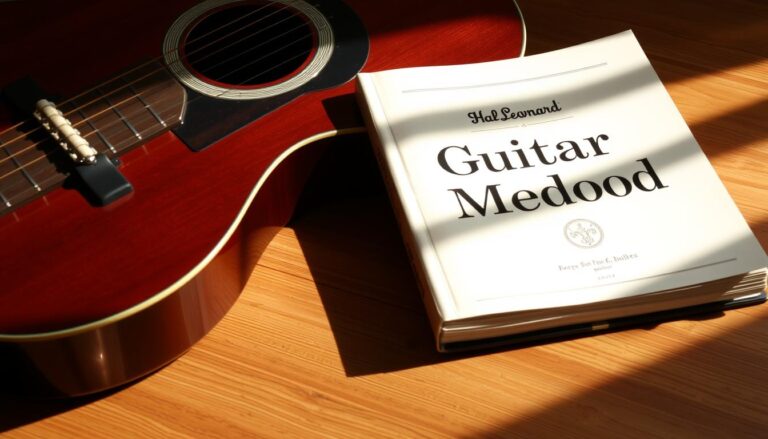Faber Adult Piano Adventures: Effective Piano Learning for Adults
Faber Adult Piano Adventures positions a two-book, spiral-bound all-in-one course for busy learners and professional studios. The series combines lessons, technique, and theory into a single reference with online audio and video support. Book 1 focuses on fundamentals: music notation, basic chord fluency, and musical form.
The redesigned layout improves information hierarchy for quick lesson reference and independent study. The method pairs a clear pacing plan with graded repertoire such as “Amazing Grace,” “The Entertainer,” and “Greensleeves” to set realistic expectations.
This evaluation reviews pacing, positions, notation, theory approach, technique structure, repertoire, levels, pricing, availability, digital media, and comparisons. It is intended for teachers, studios, and learners deciding whether to adopt one course rather than assembling piecemeal materials.
Key Takeaways
- All-in-one format: Two spiral books plus online audio and video support streamline lessons and practice.
- Book 1 essentials: Teaches notation, chord basics, and form for efficient learning piano progress.
- Redesigned layout: Improved hierarchy aids quick reference during lessons and independent study.
- Target buyers: Recommended for teachers, studios, and time-limited learners evaluating a single piano book method.
- Measurable practice: Video and audio assets support at-home work and clear progress tracking.
Faber Adult Piano Adventures Review
This review evaluates how the two all-in-one books combine lessons, technique, and theory for adult learners.
Series structure: The set consolidates lesson pages, technical drills, and theory into each spiral-bound book. That format reduces the need for separate method books and speeds lesson planning for the piano teacher.
Authors and pedigree: Written by Nancy and Randall Faber, the text sits within a broader catalog that includes graded lines for younger students. This background supports editorial consistency and reliable sequencing.
Pacing and outcomes: Progression is moderate and steady. By the end of Book 2 most students reach late-elementary reading and may move into Level 3 or Level 4 depending on review needs.
- Learner fit: Suits absolute beginners, returning players, and cross-over musicians who can use quick moves to notation and reading notes.
- Notation readiness: The method moves efficiently to staff notation; true first piano students benefit from targeted instructor support early on.
- Studio adoption: Integrated assets and clean layout simplify inventory and make the set practical for lesson-based studios.
Conclusion: As a piano method book for grown learners, the series is comprehensive and practical. Final suitability depends on goals, repertoire taste, and the level of instructor support during early notation stages.
What’s Inside the All‑In‑One Books
Each All‑In‑One volume groups lesson pages, short technique drills, and compact theory units into a single reference for time‑pressed learners. The design reduces the need to flip among multiple books and supports one course progression from basics to intermediate skills.
Book 1 emphasizes fundamentals: staff reading, basic chord playing, and form analysis presented in a mature layout for adult beginner users. Back-of-book references include major pentascales and cross-hand arpeggios for quick review.
Book 2 continues with expanded reading, one‑octave scales, coordinated patterns, and chord charts that build directly from Book 1. Online audio and video support reinforce technique and repertoire practice at home.
“The integrated unit theory pages let learners apply concepts immediately without a separate theory volume.”
- All‑in‑one structure: lessons, concise theory, and short technique routines on adjacent pages.
- Spiral binding: lays flat for easier lesson flow and in‑studio use.
- Reference aids: pentascales, arpeggios, scale library, and chord charts for at‑a‑glance review.
| Feature | Book 1 | Book 2 |
|---|---|---|
| Focus | Notation, chords, form | Reading expansion, scales, coordination |
| Technique | Short drills, cross-hand arpeggios | One‑octave scales, coordinated patterns |
| Reference pages | Pentascales, arpeggio examples | Scale library, chord charts |
| Support | Online audio/video | Online audio/video |
Practical result: A single course book path reduces inventory and simplifies lesson planning for instructors and learners. The format suits first piano students who want efficient skill building, reliable chord playing practice, and a compact music method that stays focused on core repertoire and technique.
Pacing, Positions, and Hand Mobility for Adult Beginners
A measured pacing plan and clear position sequence help returning learners and true beginners make steady technical gains.
Pacing that supports returning learners and new beginners
The method book applies a moderate pace that avoids rush and stagnation. Lessons move from black‑key familiarity to white‑key positions in a structured way.
This tempo suits time‑limited students who need clear, weekly goals tied to position shifts and short practice targets.
From Middle C and pentascales to intervals and one‑octave scales
Book 1 uses systematic positions: Middle C, neighbor variations, and C/F/G/A/D pentascales. These centers keep movement near the mid keyboard for predictability.
Late in Book 1, students extend reach to 6ths. Incremental interval work builds ergonomic awareness and measured hand span development.
Book 2 advances mobility through one‑octave scales. It begins with C and G, then adds F major, A minor, D minor, E minor, and D major. Interval targets expand up to sevenths as coordination increases.
| Phase | Key Focus | Mobility Outcome |
|---|---|---|
| Early (Book 1) | Middle C position; neighbor notes; pentascales (C/F/G/A/D) | Predictable central positions; basic reach to 6ths |
| Mid (Late Book 1) | Interval practice up to a 6th; ergonomic setup | Improved span and tension awareness |
| Advanced (Book 2) | One‑octave scales C, G → F, A, D, E; D major added | Broader fingering proficiency; intervals to 7ths |
Implementation notes: Positional shifts may feel puzzle‑like initially. Piano teachers should model hand setups, use keyboard diagrams, and set short drills to reinforce technique.
Ergonomic cues—relaxed wrist, curved fingers, and measured reach—reduce tension during transitions. The method book’s sequence gives instructors a repeatable plan for studio tracking and for assigning repertoire tied to specific technique goals.
Risk note: True brand‑new beginners may require extra instructor time on early mobility tasks to ensure correct form and prevent compensatory tension.
Reading Music, Theory Pages, and Technique Work
Instruction emphasizes an early, guided transition to grand-staff reading paired with compact theory and short technique routines.
Notation approach and reading map
The course uses named notes in noteheads as a scaffold, then shifts learners into full staff notation within a few units.
Initial pitches start at B3–E4 and expand toward C3–G4. Upper treble appears around page 82 and lower bass near page 96. Ledger lines are introduced in Book 2.
Theory in-unit pages versus a separate theory book
Unit-level theory pages appear once per unit and reinforce core concepts with short activities. These pages support lessons but often require instructor guidance.
Programs seeking greater rigor can add a dedicated theory book for practice beyond the built-in coverage.
Technique: drills, scales, and references
Technique pages prescribe 3-minute drills per unit to stabilize fingering, articulation, and coordination without long daily drills.
Back-of-book pentascales, arpeggios, and scale/chord charts link reading goals to technical work for efficient practice planning.
| Element | Location | Benefit |
|---|---|---|
| Early notation scaffold | Book 1, opening units | Faster ability to read music from staff |
| Unit theory pages | One per unit | Concise concept reinforcement |
| Technique drills | Unit technique pages | Short daily practice that builds fluency |
Risk profile: Absolute beginner piano learners may need slower note introduction and extra guidance. Returning learners and adult beginners usually adapt quickly.
Recommendation: Sequence weekly targets: reading notes, a focused technique drill, and a short theory touchpoint to maximize lesson efficiency and steady progress.
Repertoire, Song Selections, and Aesthetics Adults Appreciate
The selections span folk, classical, and several popular titles to create steady reading targets and quick performance wins. This approach supports sight‑reading growth while keeping practice engaging for the adult learner.
Representative song list and balance
- Sample songs: Amazing Grace, The Entertainer, Greensleeves, Danny Boy, Catch a Falling Star, Eine Kleine Nachtmusik, The Can-Can, The Lion Sleeps Tonight.
- Genre mix: Primarily classical and folk with select popular piano pieces to sustain interest.
Design, usability, and practice efficiency
Mature layout: Clean engraving and improved hierarchy let students scan pages quickly during short practice sessions. This reduces cognitive load and speeds lesson pacing.
Spiral-bound usability: The spiral format stays flat on a stand, enabling reliable page turns and efficient one piano setup for time‑limited practice.
Supplemental note: Companion collections (Popular, Disney, Classics, Christmas, Literature) broaden repertoire without altering core pedagogy. Studios that want more contemporary pop should add the Popular or Disney partner books.
Use case: Method books that favor melody-first arrangements support reading development and gradual chord introduction, making them suitable for studios and beginners aiming for steady, measurable progress.
Who This Piano Method Suits—and Who Might Skip It
This method targets learners who prioritize sight‑reading and structured weekly progress over ear‑first approaches.
Core audience: The series fits adult beginners, returning players, and serious teen learners seeking a literacy‑focused path. It is practical for studio settings where consistent outcomes are required.
Best fit criteria: Students who value clear notation, classical and folk repertoire, and repeatable weekly goals will benefit most. Piano teachers can scale short technique routines up or down to match a busy adult’s schedule.
Who might skip this book
Students aiming for jazz improvisation, pop-by-ear training, or chord-only learning may find the approach too reading-centric. Such learners should consider supplemental method books or partner collections for pop and improvisation.
“The reading-forward design supports predictable progress but does not prioritize ear-first or improvisation pathways.”
Teaching advice: Piano teachers should interview goals, time availability, and repertoire taste before assigning the book. Analytically inclined learners may need a supplemental theory book to expand written work beyond unit pages.
Beginner piano students with no prior exposure can succeed, but they may require slower initial guidance. For studios, the method delivers predictable progress and clear practice targets that help sustain motivation through familiar songs and a readable layout.
Levels, Path, and How the Course Fits with Other Piano Adventures
The two-volume adult track compresses several early levels into a streamlined course for efficient study.
Map coverage: These two books consolidate content comparable to Primer through early Level 3 (1A–3B equivalents) into a single course book. That consolidation reduces the number of separate method books needed for weekly lessons.
Transitions and alternative paths
After completing Book 2, most learners are prepared to enter Level 4 of the broader Piano Adventures catalog. Some students benefit from a targeted review of Level 3B material before advancing, depending on sight‑reading speed and technical consistency.
Architecture and cross-compatibility
The adult series integrates lessons, technique, and music theory on adjacent pages, unlike Basic series where content is split across coordinated titles. Notation conventions and theory frameworks match across the system, enabling smooth migration to higher levels.
- Studio advantage: One course book simplifies inventory and lesson planning.
- Placement guidance: Use scales, chord drills, and sight‑reading checks to decide if a 3B review is needed.
- Authorship continuity: The series retains editorial alignment with Nancy and Randall Faber, supporting consistent pedagogy.
Conclusion: Adult piano learners gain reduced fragmentation and clear level pathways while keeping access to the full Piano Adventures ladder for long‑term progression.
Price, Availability, and Best Places to Buy in the United States
A consistent unit price and broad distribution reduce procurement friction for teachers and music programs.
List price and typical discounts
The spiral-bound All‑in‑One Book 1 and Book 2 list for $19.99 each. This price point is stable across primary retail channels.
Amazon and SheetMusicPlus frequently run promotions that lower the effective unit cost for individuals and studios. Local stores often provide educator discounts for piano teachers when buying in bulk.
Where to buy and procurement notes
- Availability: Widely distributed via Amazon.com, SheetMusicPlus.com, HalLeonard.com, PianoAdventures.com, and U.S. local music retailers.
- Promotions: Check SheetMusicPlus and Amazon for periodic sales and multi‑unit discounts.
- Teacher benefits: Local retailers commonly offer educator pricing; this reduces per‑unit cost for studio orders.
- Inventory guidance: Verify stock and delivery timelines, especially before seasonal intake. Keep a small on‑hand inventory for new students.
- Due diligence: Read full product descriptions and sample pages where available to confirm fit before purchase.
Value case: A single course book consolidates lessons, theory, and technique, which can lower total spend compared with multiple segmented method books.
Procurement conclusion: The combination of a fixed list price, broad distribution, and routine promotions supports straightforward purchasing for U.S.-based programs and individual buyers.
Digital Support: Online Audio, Video, and Helpful Reference Pages
Streamed media and concise reference pages extend studio instruction into focused at‑home practice.
Streamable audio and video coaching
Short video segments demonstrate fingering, tempo, and phrasing so learners model correct motion. Paired audio tracks reinforce rhythm and ensemble balance for independent review.
These resources let a student cue a clip that matches a lesson. That alignment keeps home practice consistent with instructor intent and reduces error replication.
Back-of-book references and dictionaries
Book 1 includes major pentascales and cross-hand arpeggios. Book 2 compiles one‑octave scales and chord charts for rapid warmups and quick review.
Back sections also offer a compact music dictionary that defines terms likely to appear during lessons and repertoire. This supports targeted study of music theory and notation.
Practical workflow: Open the book on the stand, cue the matching video clip, and run a three-minute technique routine. Repeat with a short play-through and a focused correction session.
| Asset | Purpose | Practice Value |
|---|---|---|
| Streamable video | Technique model; tempo guide | Improves fingering and phrasing accuracy |
| Audio tracks | Rhythm and accompaniment reference | Supports timing and musicality |
| Reference pages | Pentascales, scales, chord charts, dictionary | Quick review; reduces lookup time |
Benefits: Consolidated digital assets in the all-in-one format limit multiple logins and speed practice flow at one piano. For adult piano learners with limited weekly time, these tools shorten time-to-competency.
Integrate media checkpoints into weekly assignments to validate progress and correct errors early. The combination of video, audio, and concise references creates a practical toolkit for lesson‑driven practice management.
How It Compares to Other Faber Series and Supplemental Options
This comparison summarizes how the two-volume adult course differs from youth tracks and how partner collections extend repertoire without changing core pedagogy.
Series architecture: The adult line consolidates lessons, technique, and theory into one streamlined course across two volumes. Basic and Accelerated formats distribute similar content across multiple coordinated method books, creating more segmented progression for younger learners.
Target demographics: My First targets ages 5–6. Basic serves ages 7–11. Accelerated fits ages 12–17. The adult track is designed for learners 18+ with goals of rapid literacy and practical technique.
Practical contrasts and studio impact
The two-volume plan reduces inventory and simplifies tracking for studios. Fewer volumes per student lower procurement costs and administrative overhead while preserving editorial consistency by Nancy and Randall Faber.
| Series | Volume structure | Primary focus |
|---|---|---|
| My First | Multiple early primers | Foundational games and simple notation |
| Basic / Accelerated | Segmented method books | Incremental concepts and staged theory |
| Adult (two-volume) | Integrated one course | Rapid literacy; practical technique |
Partner books: Popular, Disney, Classics, Christmas, and Literature collections extend repertoire without altering the course framework. These supplements let programs add genre variety while keeping the same method book progression.
“The consolidated format supports efficient lesson planning and clear progression while maintaining cross-series compatibility for placement and advancement.”
Adoption scenarios: Community adult cohorts and time-limited learners benefit from the one-course approach. Mixed-age studios may retain Basic/Accelerated tracks for youth while offering the two-volume plan for mature beginners and returning students.
Conclusion
A compact two-book system delivers structured lesson flow, short drills, and integrated media for measurable weekly progress.
The two-volume course helps adult piano learners read music, build steady technique, and develop basic chord playing within a single spiral-bound book pair. It combines unit theory pages, three-minute drills, and streamable audio/video to speed proficiency for time-limited students.
Expected outcomes include reliable sight-reading growth and readiness to transition to higher-level materials after Book 2. Ideal users are beginner adults, returning players, and serious teens focused on music literacy and consistent weekly progress.
Limitations: those seeking improvisation-first or pop-by-ear tracks should use supplemental resources. Procurement is straightforward: stable pricing and broad U.S. availability simplify adoption.
Recommendation: For a concise, studio-ready piano method book, the Faber Piano adult piano adventures set is a dependable foundation when aligned with clear practice goals and instructor support.
FAQ
What is Faber Adult Piano Adventures and who designed it?
Faber Adult Piano Adventures is a structured method book series developed by Nancy Randall Faber and Randall Faber. It targets adult beginners and returners with integrated lessons that combine notation, technique, and theory in an accessible course format.
What materials are included in the All‑In‑One books?
The All‑In‑One books combine course book lessons, integrated theory pages, and technique exercises. Book 1 emphasizes fundamentals, music notation, basic chords, and musical form; Book 2 expands chord vocabulary, introduces scales and intervals, and advances sight‑reading and repertoire.
How suitable is this method for someone returning to the keyboard after a long break?
The pacing is calibrated for adult learners, with progressive positions from Middle C and pentascales to one‑octave scales. Short technique routines, mobility drills, and clear stepwise progression support efficient relearning and retention.
How quickly does the series move students to reading the grand staff?
The notation approach prioritizes a prompt transition to the grand staff with incremental note additions. Music theory is embedded in-unit, enabling learners to apply notation, chords, and rhythms immediately rather than deferring to a separate theory manual.
What types of technique work are provided in the books?
Technique includes brief daily drills (three‑minute patterns), scale and arpeggio exercises, hand‑position guidance, and reference charts for pentascales and chord shapes to improve agility and hand mobility.
What repertoire can students expect and how is the layout designed for adults?
Repertoire features familiar tunes such as “Amazing Grace,” “The Entertainer,” and “Greensleeves,” plus popular selections arranged for developing players. The books use a mature layout with improved typographic hierarchy and spiral‑bound options for practical usability during practice.
Which learners will benefit most from this method and who might choose another route?
The series is well suited to adult beginners, returning players, and serious teen learners seeking a single‑course solution with theory and technique integrated. Candidates who require a purely classical conservatory track or accelerated exam preparation may supplement with other method books or specialist repertoire.
How do the two All‑In‑One volumes map to standard levels?
Collectively the two books cover material roughly from Primer through early Level 3 and into Level 4 territory. They provide a continuous path before learners transition to higher Level 4‑6 repertoire or supplemental method books.
What is the typical price range and where can purchasers find these books in the United States?
List prices vary by retailer; typical discounts can be found through major outlets. Common purchase points include local music stores, Amazon, SheetMusicPlus, and Hal Leonard; availability and pricing fluctuate, so checking multiple vendors yields the best value.
Are there digital resources that accompany the books?
Yes. Streamable audio and video materials support at‑home practice, alongside back‑of‑book reference pages such as pentascales, arpeggios, chord charts, and brief dictionaries that reinforce learning and teacher instruction.
How does this series compare with other method books from the same publisher?
Compared with Basic, Accelerated, and My First series, this course is tailored for mature learners with integrated theory and adult‑sized repertoire. It also pairs effectively with supplemental collections like Popular, Disney, Classics, and Literature for expanded song selections.






